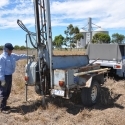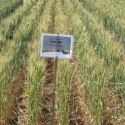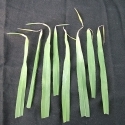21 May 2015
Sandblasting in the Mallee
Not everything is nutrition or disease

Simon Craig (AGRONOMISE Pty Ltd, simon@agronomise.com.au) provided these pictures of a barley crop on a sandhill in the Victorian Mallee. The paddock was sown in mid April and seed bed moisture was good. The previous crop was triazine-tolerant canola and the paddock has adequate levels of N and P. Crop establishment was even initially until there were windspeeds up to 100 km/h from the west-north-west in early May.
While some nutritional constraints could be proposed, Simon's conclusion is that sandblasting has damaged the crop where it is not protected from standing stubble. This type of damage is consistent across most sandy paddocks and in different crop types including lupins, which suggests a climatic event more than a nutritional limitation.
When looking at crop damage, look for patterns and associations rather than just the symptoms. For example, where crop damage occurs in straight lines, suspect issues association with seeding or spraying equipment such as overspray or deep/shallow seeding or poor fertilizer placement. Patches are more commonly soil or pathogen related and symptoms can be used to assist diagnosis. If nutritional limits are suspected, then plant tissue testing - from good and poor patches analyzed separately - can help significantly.
The free IPNI nutrient deficiency iPad and iPhone app - see at left - is available to assist with diagnosis of crop disorders.








